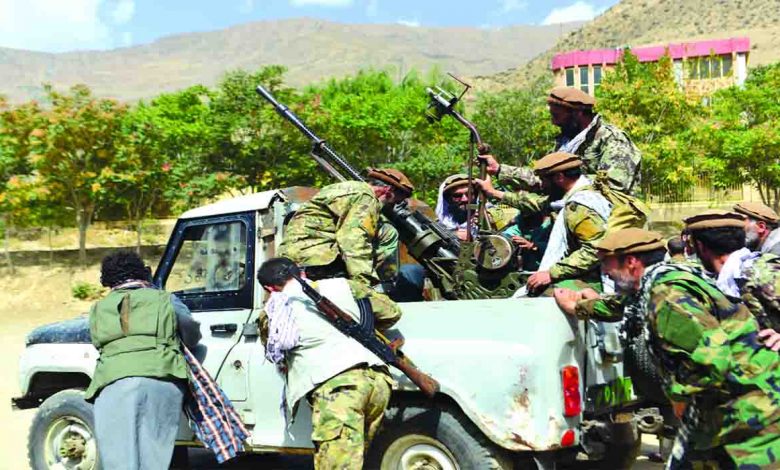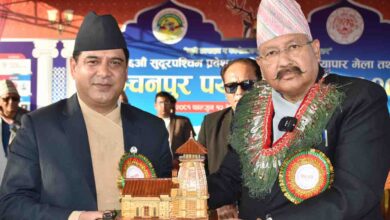Taliban face Panjshir resistance

Thursday, 02 September 2021 | afp/Agencies | PANJSHIR VALLEY (Afghanistan)
NRF vows to defend enclave against Taliban; Af set to see new govt led by Taliban supreme leader Akhundzada
The Taliban on Wednesday called on the holdout bastion of the Panjshir Valley to lay down their arms as resistance fighters said they had repulsed heavy attacks.
The rugged mountain valley with towering snow-capped peaks — which begins around 80 kilometres (50 miles) north of Kabul — is the centre of Afghanistan’s most important pocket of armed anti-Taliban forces.
The National Resistance Front (NRF), comprising anti-Taliban militia fighters and former Afghan security forces, has vowed to defend the enclave as the Islamist group sends fighters to encircle the area.
“My brothers, we tried our best to solve the Panjshir problem with talks and negotiations… but unfortunately all in vain,” senior Taliban official Amir Khan Muttaqi said, in an audio message to the people of the Panjshir posted on Twitter.
“Now that the talks have failed and Mujahiddin (Taliban) have surrounded Panjshir, there are still people inside that don’t want the problems to be solved peacefully,” he added.
“Now it is up to you to talk to them,” the Taliban message to the Panjshir people said. “Those who want to fight, tell them it is enough.”
Bismillah Mohammadi, Afghanistan’s Defence Minister before the Government fell last month, said the Taliban had launched a renewed assault on Panjshir on Tuesday night. “Last night the Taliban terrorists attacked Panjshir, but were defeated,” Mohammadi tweeted on Wednesday, claiming 34 Taliban were killed and 65 wounded. “Our people should not worry. They retreated with heavy casualties.”
Meanwhile, the Taliban and other Afghan leaders have reached a “consensus” on the formation of a new government and cabinet under the leadership of the group’s top spiritual leader, an official said. Taliban supreme commander Haibatullah Akhundzada will be the top leader of any governing council, Bilal Karimi, a member of the group’s cultural commission said on Wednesday. Mullah Abdul Ghani Baradar, one of Akhundzada’s three deputies and the main public face of the Taliban, is likely to be in charge of the daily functioning of the government, Karimi added.
“The consultations on forming an inclusive Afghan government within the Islamic Emirate’s leaders, with the leaders from previous government and other influential leaders have officially ended,” Karimi said. “They have reached a consensus. We’re about to announce a functioning cabinet and government in a few days, not weeks.”
Residents and fighters in Panjshir, many of whom fought the Taliban when they were last in power from 1996 to 2001, offered a defiant message. “We are ready to defend it till the last drop of our blood,” said one resident.
“Everyone has a weapon on their shoulder and ready to fire,” another said. “From the youngest to the oldest, they all talk about resistance.” As the last US soldiers boarded their flight out of Afghanistan in the Kabul dark late on Monday, residents of Panjshir said the Taliban had attacked the valley on two fronts — the Khawak pass in the west, and from Shotol to the south.
“Perhaps they wanted to try their luck,” NRF official Fahim Dashti said in a video posted Tuesday by the US broadcaster Voice of America’s Dari language service. “By the grace of God, luck wasn’t on their side.”
Dashti reported seven or eight Taliban fighters were killed in Monday’s clashes along with one or two resistance fighters.
The Panjshir has immense symbolic value in Afghanistan as the area that has resisted occupation by invaders. “We defended it during the era of the Russians, the era of the British, the previous era of the Taliban… we will continue to defend it,” one fighter said.
Ahmad Massoud, one of the NRF’s leaders, is the son of the late guerrilla commander Ahmad Shah Massoud, who was dubbed the “Lion of Panjshir” for holding out, first against Soviet and then Taliban forces.
The valley has limited entry points and its geography offers a natural military advantage — defending units can use high positions to effectively target attacking forces.
This week, Panjshir fighters held military training in a show of force, with men carrying heavy logs on their shoulders crossing chest-deep icy rivers. Above their armoured vehicles and over their bases fluttered their flag, a challenge to the Taliban’s white banner now hauled up across the rest of the country.
Many Afghans are terrified of a repeat of the Taliban’s initial rule from 1996 to 2001, which was infamous for their treatment of girls and women, as well as a brutal justice system.
The NRF has set up machine gun nests, mortars and surveillance posts fortified with sandbags in anticipation of a Taliban assault.
Communications are difficult with the valley, with Taliban forces on three sides. Internet into Panjshir has been on and off repeatedly in recent days.






